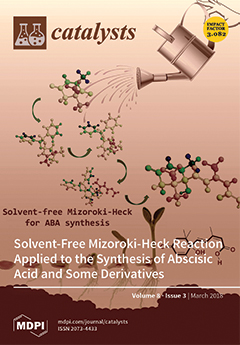In this study, α-Fe
2O
3 spherical particles with an average diameter of approximately 200 nm were synthesized by a solvothermal method for use as both a catalyst and medium for a Pd catalyst. The kinetics of CO oxidation over powders of α-Fe
2O
3 spherical particles and 14 wt % Pd/α-Fe
2O
3 spherical particles were measured in a static reactor by using a CO
2 laser-based photoacoustic technique. The total pressure was fixed at 40 Torr for the CO/O
2/N
2 mixture for temperatures in the range of 225–350 °C. The variation in the CO
2 photoacoustic signal with the CO
2 concentration during CO oxidation was recorded as a function of time, and the CO
2 photoacoustic data at the early reaction stage was used to estimate the rates of CO
2 formation. Based on plots of ln(rate) vs. 1/
T, apparent activation energies were calculated as 13.4 kcal/mol for the α-Fe
2O
3 submicron powder and 13.2 kcal/mol for the 14 wt % Pd/α-Fe
2O
3 submicron powder. Reaction orders with respect to CO and O
2 were determined from the rates measured at various partial pressures of CO and O
2 at 350 °C. The zero-order of the reaction with respect to
Po
2 was observed for CO oxidation over α-Fe
2O
3 submicron powder, while 0.48 order to
Po
2 was observed for CO oxidation over Pd/α-Fe
2O
3 submicron powder. The partial orders with respect to
PCO were determined as 0.58 and 0.54 for the α-Fe
2O
3, and the Pd/α-Fe
2O
3 submicron powders, respectively. The kinetic results obtained from both catalysts were compared with those for the α-Fe
2O
3 fine powder catalysts and were used to understand the reaction mechanism.
Full article





